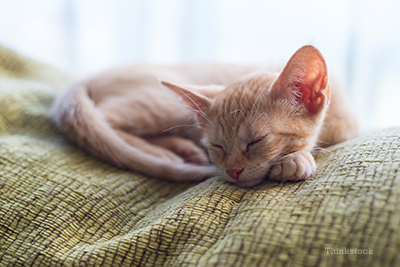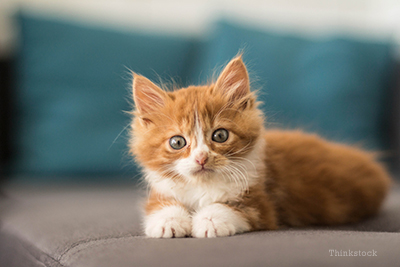
Transitioning a cat from one type of environment – urban or rural – to another can be a challenge, particularly if you are planning to keep your city cat inside. With a bit of planning and the right tools, you can ease your cat through the process with minimal stress on your feline companion.
Prepping the new environment
Moving from a rural or suburban area, where your cat was able to access the outdoors on a regular basis, to a city environment, means your cat most likely will need to be confined indoors for her own safety. You can still allow your cat to enjoy the space though and provide her with regular enrichment activities.
Installing some cat trees in your new urban home will give the cat multiple areas to climb and explore. Provide a variety of trees (vertical, horizontal and trees that have spaces cats can go in and out of). You also will want to provide plenty of scratching posts. Cats that have been outdoors regularly may be used to marking and scratching trees and other surfaces and will need a proper outlet for this natural behavior. If your urban home is too small for cat trees, another option is to install carpeted shelving on the walls at various heights so your cat can use these to explore.
Window boxes and shelves are another great option that will allow your kitty to see the outside world. If you have the space, such as in an apartment or condominium patio, you can install a completely screened in area with a cat door designed for use with sliding doors. The space gives your cat a chance to come and go outside on her own, but keeps her safe from jumping off the patio area.
Installing a bird feeder near the window or patio area can also give your cat hours of mental enrichment. One important caution is being aware of what is known as Feline High Rise Syndrome . According to the ASPCA, cats have been known to incorrectly estimate the height they are at and will jump out windows and either severely injure themselves or suffer fatalities. A previously outdoor cat is very likely to be interested in looking out the windows of your apartment, so make sure all windows and screens are securely latched and cat-tamper proof.
Litter boxes
Cats that have previously been outdoors and have not used litter boxes in the home may have some initial difficulties with adjusting to using a box. You should provide multiple boxes and rotate the locations until you determine which areas your cat appears most comfortable using. You may also find your cat rejecting commercially made litter so sand and/or dirt may be an option as these are substrates the cat is used to using.
not used litter boxes in the home may have some initial difficulties with adjusting to using a box. You should provide multiple boxes and rotate the locations until you determine which areas your cat appears most comfortable using. You may also find your cat rejecting commercially made litter so sand and/or dirt may be an option as these are substrates the cat is used to using.
Keeping your cat’s mind stimulated
Finally, keeping your cat well occupied, both physically and mentally, can reduce the stress she will feel upon no longer being able to go outside. Take the time to play with your cat each day with toys that she enjoys, such as cat pull toys, feathers, balls and interactive food puzzles. Clicker training your cat to do basic behaviors is also a wonderful way to keep her mentally healthy and engaged. If your cat is amenable to other cats, you might also consider getting her a new feline friend, although this is best postponed until you are well settled in your new home, as the added stress of a new friend combined with a new move can be quite a lot for a cat to handle at once.
Country Cat —City Cat
Moving a cat from an urban to a rural or suburban environment poses challenges of its own. This is often the time when pet guardians may decide to allow their cat to go outdoors. However, many prominent organizations, including the ASPCA, Humane Society of the United States, AVMA and the American Association of Feline Practitioners advocate keeping cats indoors in all environments. Cats that are allowed outdoors are at risks including:
- Diseases from parasites (fleas, ticks, heartworm and more)
- Injury or potential death from attacks by wild animals or other neighborhood pets
- Becoming lost because they are unfamiliar with their surroundings
- Increased risk of being hit by cars
Keeping cats indoors also protects the wild bird population, as it’s estimated by Audubon.org that domestic cats kill 1.4 to 3.7 billion birds a year in the U.S. alone.
If you decide that you still want to allow your cat to enjoy your new natural surroundings, you do have some “safe” options, including:
- A fully screened in cat enclosure in your yard or on a patio— You can purchase pre-made versions or even build your own (if you build your own, make sure the screen material you use is indestructible to cat claws). You want to also be sure to only allow your cat in this area supervised, as you don’t want wild animals or other cats, both stray and owned, to harass your cat.
Even if your cat is always kept inside, make sure she is microchipped and wears a collar with an ID. While you will want to be sure that your enclosure is as escape-proof as possible, these additional precautions can ensure that your cat will be returned to you if she escapes.
If find yourself still needing help with your cat’s transition, visit the American College of Veterinary Behaviorists, the Animal Behavior Society, the American Association of Feline Practitioners and the International Association of Animal Behavior Consultants to find a qualified professional near you who can assist you and your feline.
If you have any questions or concerns, you should always visit or call your veterinarian -- they are your best resource to ensure the health and well-being of your pets.
